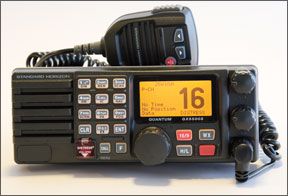I’m a member of the Stonington Harbor Yacht Club in Stonington, Conn., and we need a better way to contact members on the water. We would like to use the full features of DSC (Digital Selective Calling) group calling for that purpose, but it is not clear to us what the best way is to obtain a group identity call number for DSC calls.
If anyone on your staff has knowledge about this matter, we would appreciate the advice.
Rick Gleason
Stonington, Conn.,
Via e-mail
Most fixed VHF radios (and some high-end handhelds) that feature DSC also have the ability to set and store a Group Identity Number. This number, which is shared among all the boats in a “group” or fleet, operates like a shared phone number, allowing one station to simultaneously contact multiple boats. Unlike the individual Marine Mobile Station Identity (MMSI) number that is assigned to your radio when you buy and register it with BoatU.S. or another organization that handles the registration process, the Group Identity Number is not assigned. The user can simply sets the nine-digit number himself. Ideally, this is done in accordance with the established numbering protocol (described below).

288
Usually the process for setting a Group Identity Number can be found somewhere in the VHF owner’s manual. Some manuals state instructions clearly, and in others, there is no explanation whatsoever how to use this feature.
Fishing fleets, commercial boats, yacht clubs, and racing sailboats sometimes use group Group Identity Number. Although the owner of a DSC-capable VHF radio can set any Group Identity Number he wants, there are certain rules that should be followed. Just like a phone number, in which an area code is assigned to specific calling regions, a Group Identity Number is also determined by geography.
The Group Identity Number consists of nine digits. The first digit is always “0,” as set by international rules. The following three digits are called Mobile Identity Digits (MID). All U.S.-registered boats should have an MID of “338.” Canadian boats should use “316” as the MID. You can find out the MIDs for various countries around the world at the International Telecommunication Union’s website,
www.itu.int/cgi-bin/htsh/glad/cga_mids.sh?lng=E.
The Group Identity Number’s last five digits can be whatever the fleet settles on, so long as no other group has chosen that sequence. All the members of the group will enter the same nine-digit Group Identity Number into their radios.
When someone places a call to the group number, all the radios that share that number will emit a tone and automatically switch to a designated working frequency. In this way, racing fleets or participants in a rally can be quickly and simultaneously contacted to pass on navigational, weather, or other information.
In the case of the members of your yacht club, the Group Identity Number could be used to warn members in a Wednesday night race of a log or floating object spotted on the course.
You should find directions for programming a Group Identity Number into your particular radio in the owner’s manual. Then again, you might not.


































